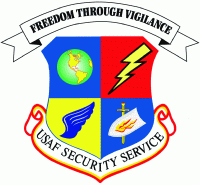"Freedom Through Vigilance" Reviews 
While not a review in the traditional sense, the Foreword to Freedom Through Vigilance written by retired USAFSS Senior Master Sergeant William G. Deister offers an excellent, meaningful assessment of the extent to which the book addresses U.S. Air Force Security Service history. An old friend, Bill Deister also edited Freedom Through Vigilance.
Foreword
While thinking of an opening for this foreword, I found myself imagining television's beloved Mr. Rogers asking, "Can you say, u-sahf-fuss?" Some readers may wonder why anyone would want to say such a strange word. But to thousands of Air Force veterans, USAFSS - the United States Air Force Security Service - was their home in the military, whether for one hitch or a long career. To a person they are proud to have served in the smallest major command in the Air Force - to them simply Command. For decades, they didn't talk about what they did. It was top secret. If people believed they were the Military Police, well, fine. In recent years, however, declassification has allowed much of the signals intelligence (SIGINT) mission of Security Service, and its successor commands and agencies, to be discussed openly.
In Freedom Through Vigilance, author and retired USAFSS veteran Larry Tart has given us a rare glimpse into Air Force signals intelligence operations. Although most of the book treats the Security Service years, the author follows the SIGINT mission through a succession of increasing responsibilities leading to new command designations: Electronic Security Command (ESC), Air Force Intelligence Command (AFIC), Air Intelligence Agency (AIA), and Air Force Intelligence, Surveillance, and Reconnaissance Agency (AFISRA).
Those responsibilities have grown through some seven decades to meet challenges posed by modernizing communications systems. When USAFSS was established in 1948, and for many years during the Cold War, its military targets communicated primarily by Morse code. Over time the use of voice radio became more common, and the book relates the history of operations to intercept and exploit both types of signals. Finally it introduces the mission of AFISRA, in an age of digital data and cellphones, in waging the global war against terror following Al Qaeda attacks on the United States on September 11, 2001.
In its breadth, Freedom Through Vigilance encompasses the establishment and physical building of units and bases, and it discusses all mission activities, including signals collection, radio direction finding, processing, analysis and reporting - sometimes during periods of national crisis and war. Much information about units is set out in clearly organized tables. While reading this incredibly detailed yet readable history, Security Service veterans will feel right at home with the vocabulary that once was everyday for them. Many personal accounts, obtained in interviews, from outside sources, and by email, support factual information while at times bringing excitement and humor to the history. Larry even shares a few amusing stories of his own about off-duty life in Europe. The text, written in a blend of formal and informal styles that flows smoothly, is enriched by an extensive collection of photographs.
The author felt that FTV's content called for an editor having certain skills and a knowledge of the mission and culture of Security Service, and Larry invited me to fulfill that requirement. Like him, I am a retired career Russian linguist, and more recently a retired high school teacher of social studies and Russian language. We are old friends, having been classmates in Advanced Russian at the Defense Language Institute, Monterey, for most of 1971. I had previously taken Basic and Intermediate at Syracuse and the 12-week RS-425 Advanced Special Russian Transcription course at Ft Meade. My own assignments over 24 years primarily involved collection and transcription, with some target analysis at Spec Comm in my first term, three years out of Command well into my career and one year in HQ at Kelly in General Larson's brand-new Alert Center in 1979-1980. I served three two-year tours at the National Security Agency (NSA), three tours in Japan, and two in Europe, and I hold three career professionalization certifications from NSA. I knew many of the persons who shared their experiences with the author.
Freedom Through Vigilance pays public tribute to Air Force SIGINT veterans who have cherished in silence memories of their accomplishments, often performed under adverse circumstances or in remote and dangerous places. They will see themselves in this book, even if not named, as they read about the men and women, from airman to general, with whom they performed their vital mission. One of the standout personal accounts comes from the author's friend, Paul Strieby, who expresses his feelings about the importance of the mission in words that we all feel, even if we didn't get to be in on something so "hot." Also noteworthy for their inspiration are comments about making the most of opportunities offered by Chief Master Sergeant Suzan Sangster, currently serving in the Air Force Intelligence, Surveillance, and Reconnaissance Agency, today's successor to USAFSS. The book contains stories of many SIGINT airmen who did take the opportunities open to them and built very fine careers.
Readers of Larry Tart's new book, civilian or military, cannot help but be deeply impressed by the technical expertise, resourcefulness, bravery, and limitless devotion to duty of the airmen and officers who were Security Service.
William G. Deister
SMSgt, USAF, Ret.
| Order an autographed copy of FTV | Contact Larry Tart | Return to FTV Main Menu | Return to Home Page |